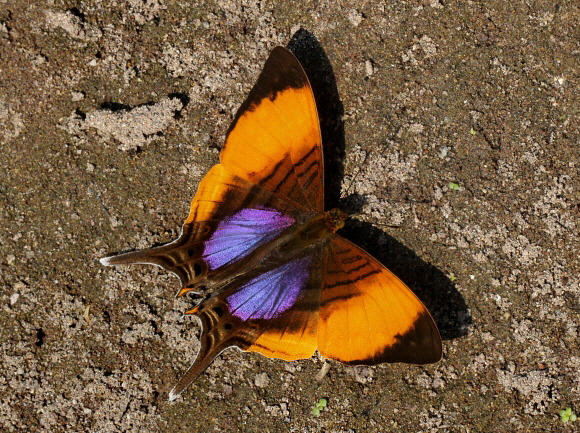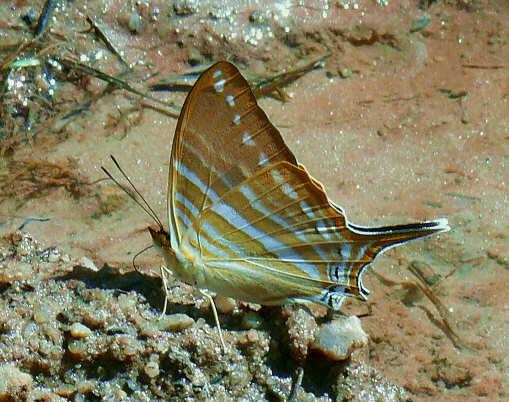 Marpesia marcella, Tingo Maria, Peru – Adrian Hoskins
Marpesia marcella, Tingo Maria, Peru – Adrian Hoskins
Introduction
The genus Marpesia is confined largely to the neotropical region, but is closely allied to the Mapwing and Maplet butterflies ( Cyrestis & Chersonesia ) of the Oriental region.
Daggerwings are similar in wing shape to Swordtails and Swallowtails ( Papilionidae ), but the latter have 6 legs whereas Marpesia and all other Nymphalidae genera have only 4 legs. Another feature to look for is the antennae. In all Papilionids these are recurved at the tip, but in Marpesia they are straight. In total there are 17 Marpesia species, all with the same wing shape as zerynthia, except for petreus which has 2 tails on each hindwing and a deeply scalloped outer margin to it’s forewing.
Males of Marpesia marcella can easily be confused with corita and corinna, both of which have very similar uppersides, although the orange bands are narrower in corinna. The females of marcella and corinna are dark brown with white bands on the forewings, but females of corita have orange bands.
On the underside marcella is pale orange with broad linear white stripes, while corinna is similar but has much narrower stripes. Both are quite different from corita which is pinkish-brown, marbled and scalloped with purplish on the outer half of the wings, and marked with irregular white stripes in the basal area.
Marpesia marcella occurs from Mexico to Peru.
Habitats
Although it is found at all elevations from 500-2800m, Marpesia marcella is primarily a cloudforest species, and is most abundant at elevations between about 1000-2000m.
Lifecycle
I have no data relating to marcella, but the following characteristics are applicable in general to the genus Marpesia : The eggs are white or yellowish, and laid singly on the foliage of trees and shrubs in the family Moraceae – including Ficus, Chlorophora, Brosimum and Artocarpus. The fully grown caterpillars are very colourful, typically marked with red and / or yellow spots and stripes. There is a single row of unbranched, recurved spines along the back, and the head is adorned with a pair of very long wavy spines. They feed diurnally and rest on the upper surface of leaves. The pupae are typically pale in colour, marked with blackish spots or blotches, and have wiry filaments projecting from the back of the abdomen and from the head.
Adult behaviour
This species is usually encountered as small groups of up to about 6 males, visiting wet sand or mud to imbibe mineral-laden moisture. In hot weather the butterflies tend to constantly flit from spot to spot, fanning their wings, but occasionally settle for a while and feed while holding their wings erect. In cooler or shady conditions they feed with wings outspread.
Females are elusive, spending most of their lives in the forest canopy, but in overcast weather will sometimes descend to settle on foliage along forest trails.
 Marpesia marcella, male, Colombia – Frank Lambert
Marpesia marcella, male, Colombia – Frank Lambert
